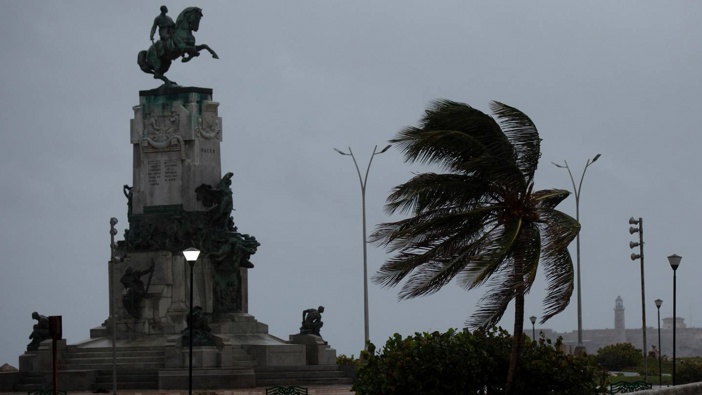Follow
the podcast on

Hurricane Ian tore into western Cuba as a major hurricane, with nothing to stop it from intensifying into a catastrophic Category 4 storm before it crashes ashore in Florida, where officials ordered 2.5 million people to evacuate.
Ian made landfall at 4.30am EDT Tuesday in Cuba's Pinar del Rio province, where officials set up 55 shelters, evacuated 50,000 people, rushed in emergency personnel and took steps to protect crops in the nation's main tobacco-growing region.
The US National Hurricane Center said "significant wind and storm surge impacts" occurred Tuesday morning in western Cuba. Ian struck with sustained top winds of 205km/h. As much as 4.3m of storm surge was predicted along Cuba's coast.
/cloudfront-ap-southeast-2.images.arcpublishing.com/nzme/N3NMC5M6CSRXKZ27ZH23OK2XKY.jpg)
Traffic builds along Interstate 4 in Tampa, Florida as Hurricane Ian approaches. Photo / Willie J. Allen Jr, Orlando Sentinel via AP
Ian was forecast to strengthen even more over warm Gulf of Mexico waters, reaching top winds of 225km/h as it approaches Florida's southwest coast. Tropical storm-force winds were expected across the southern peninsula late Tuesday, reaching hurricane force Wednesday morning.
"Right now we're focusing on west central Florida area as the main area for impact," hurricane specialist Andy Latto told The Associated Press on Tuesday.
/cloudfront-ap-southeast-2.images.arcpublishing.com/nzme/IHDN75II2S5GEDY552WV2F4P4M.jpg)
Shoppers at the Costco store in Altamonte Springs, Florida grab bottles of water from the last pallet in stock. Photo / Joe Burbank, Orlando Sentinel via AP
With tropical storm-force winds extending 185km from Ian's centre, damage was expected across a wide area of Florida, regardless of where Ian makes landfall. The hurricane centre expanded its storm surge warning to the peninsula's Atlantic coast, and expanded its tropical storm warning from Boca Raton to Brunswick, Georgia — a distance of about 603km.
/cloudfront-ap-southeast-2.images.arcpublishing.com/nzme/YGLBNDAEVT42ULEE5EICCWNJV4.jpg)
Waves crash against a seawall as Hurricane Ian passes through George Town, Grand Cayman island. Photo / Kevin Morales, AP
Gil Gonzalez boarded his windows with plywood Tuesday and had sandbags ready to protect his Tampa home from flooding. He and his wife had stocked up on bottled water and packed torches, battery packs for their cellphones and a camp stove with a large propane burner as they got ready to evacuate.
"All the prized possessions, we've put them upstairs in a friend's house and nearby, and we've got the car loaded," Gonzalez said. He added: "I think we're ready."
Florida Governor Ron DeSantis said an estimated 2.5 million people were under evacuation orders. He urged people to prepare for power outages and to get out of its way.
"When you have five to 10 feet of storm surge, that is not something you want to be a part of," DeSantis said Tuesday. "And Mother Nature is a very fearsome adversary."
/cloudfront-ap-southeast-2.images.arcpublishing.com/nzme/MPRTUFFX6HRXEWXAKPNUHUAIWQ.jpg)
Hurricane Ian grew stronger as it barreled toward Cuba. Photo / Nasa Worldview, Earth Observing System Data and Information System via AP
The hurricane centre expanded its hurricane warning to include Bonita Beach north through Tampa Bay to the Anclote River. Fort Myers is in the hurricane zone, and Tampa and St Petersburg could get their first direct hit by a major hurricane since 1921.
"People on the barrier islands who decide not to go, they do so at their own peril," Roger Desjarlais, county manager of Lee County, where Fort Myers is, said early Tuesday. "The best thing they can do is leave."
The county issued mandatory evacuations for low-lying areas including Fort Myers Beach, Sanibel and Bonita Beach, where about 250,000 people live.
/cloudfront-ap-southeast-2.images.arcpublishing.com/nzme/POOPDYVHZ5TKHQXSP52MOKKM7Q.jpg)
Florida Governor Ron DeSantis, left, speaks as he stands with Kevin Guthrie, director of the Florida Division of Emergency Management. Photo / Chris O'Meara, AP
As the storm's centre moved into the Gulf, scenes of destruction emerged in Cuba's world-famous tobacco belt. The owner of the premier Finca Robaina cigar producer posted photos on social media showing wood-and-thatch roofs smashed to the ground, greenhouses in rubble and wagons overturned.
"It was apocalyptic, a real disaster," wrote Hirochi Robaina, grandson of the operation's founder.
State media published photos showing broad floodwaters flowing through the town of San Juan y Martinez and more than 1 million Cubans were without power Tuesday morning, including all of the western provinces of Pinar del Rio and Artemisa. There were no reports of deaths.
/cloudfront-ap-southeast-2.images.arcpublishing.com/nzme/6VSSVVLZVXHBV3MGVUA35J6UXE.jpg)
A resident uses plastic as protection from the rain in Batabano, Cuba. Photo / Ramon Espinosa, AP
Ian's forward movement was expected to slow over the Gulf, enabling the hurricane to grow wider and stronger before it brings punishing wind and water to Florida's west coast. Forecasters said the surge of ocean water could reach 3m if it peaks at high tide. Rainfall could total 410mm with as much as 610mm in isolated areas. Coastal communities could be inundated.
In Key West, the airport closed Tuesday as gusty rains from the storm added to a king tide to swamp the streets, prompting animal rescuers to delay venturing out until after Ian passes.
In Orlando, Disney World closed four hotels as a precaution while holding off on any decision to shut down its theme parks. Busch Gardens in Tampa closed at least through Thursday. In Florida's northeastern corner, the US Navy said it planned to move ships and aircraft from its base outside Jacksonville.
/cloudfront-ap-southeast-2.images.arcpublishing.com/nzme/MSVOYCQGCNYQDMDXSZ2GNTXKJQ.jpg)
As Hurricane Ian approaches Florida, shopping carts are left abandoned next to empty shelves that stock bottled water at a supermarket. Photo / John Raoux, AP
Playing it safe, Nasa was rolling its moon rocket from the launch pad to its Kennedy Space Center hangar, adding weeks of delay to the test flight. The airports in Tampa and St. Petersburg announced they'll close Tuesday afternoon.
President Joe Biden also declared an emergency, authorising the Department of Homeland Security and the Federal Emergency Management Agency to coordinate disaster relief and provide assistance to protect lives and property. FEMA has strategically positioned generators, millions of meals and millions of litres of water, White House press secretary Karine Jean-Pierre said.
/cloudfront-ap-southeast-2.images.arcpublishing.com/nzme/RZNMOP52E7KPUUNGM3DGJXLVZM.jpg)
News crews, tourists and residents take images as high waves from Hurricane Ian crash into the seawall at the Southernmost Point buoy. Photo / Rob O'Neal, The Key West Citizen via AP
Damaging winds and flooding are expected across the entire peninsula as Ian moves north, reaching into Georgia, South Carolina and other parts of the southeastern US between Friday and Sunday, the hurricane centre said.
— Cristina Mesquita & Curt Anderson, AP
Take your Radio, Podcasts and Music with you









